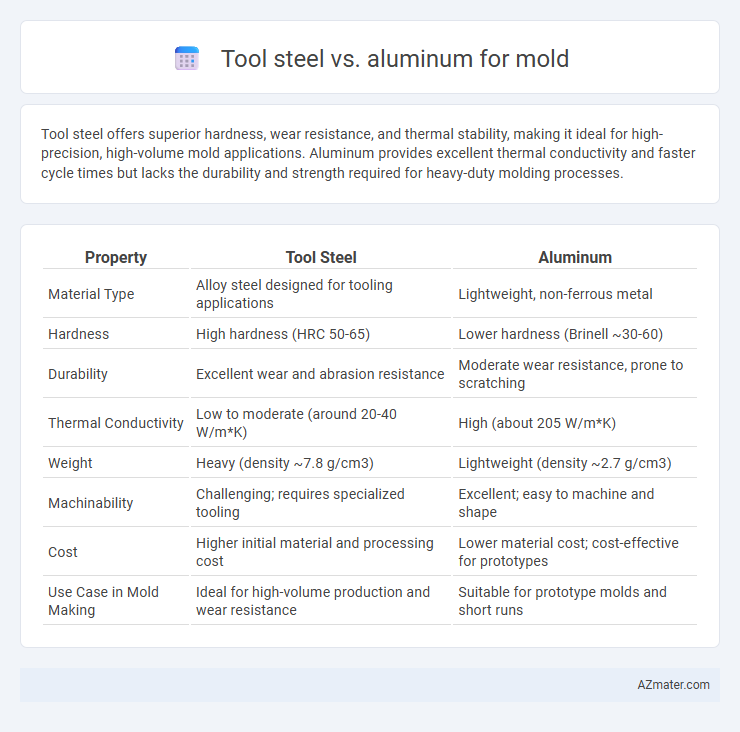Tool steel offers superior hardness, wear resistance, and thermal stability, making it ideal for high-precision, high-volume mold applications. Aluminum provides excellent thermal conductivity and faster cycle times but lacks the durability and strength required for heavy-duty molding processes.
Table of Comparison
| Property | Tool Steel | Aluminum |
|---|---|---|
| Material Type | Alloy steel designed for tooling applications | Lightweight, non-ferrous metal |
| Hardness | High hardness (HRC 50-65) | Lower hardness (Brinell ~30-60) |
| Durability | Excellent wear and abrasion resistance | Moderate wear resistance, prone to scratching |
| Thermal Conductivity | Low to moderate (around 20-40 W/m*K) | High (about 205 W/m*K) |
| Weight | Heavy (density ~7.8 g/cm3) | Lightweight (density ~2.7 g/cm3) |
| Machinability | Challenging; requires specialized tooling | Excellent; easy to machine and shape |
| Cost | Higher initial material and processing cost | Lower material cost; cost-effective for prototypes |
| Use Case in Mold Making | Ideal for high-volume production and wear resistance | Suitable for prototype molds and short runs |
Introduction to Mold Materials: Tool Steel vs Aluminum
Tool steel offers superior hardness, wear resistance, and thermal fatigue strength, making it ideal for high-volume, precision mold applications requiring durability and longevity. Aluminum molds provide excellent thermal conductivity, enabling faster cooling cycles and reduced production times, but they typically lack the strength and wear resistance needed for extended use. Selecting between tool steel and aluminum depends on the required mold lifespan, production volume, and cost efficiency in manufacturing processes.
Material Properties Overview
Tool steel offers superior hardness, wear resistance, and thermal stability compared to aluminum, making it ideal for high-precision mold applications requiring durability under heavy-duty cycles. Aluminum provides excellent machinability, lightweight characteristics, and good thermal conductivity, resulting in faster cycle times and reduced mold cooling duration but with lower resistance to abrasion and deformation. Choosing between tool steel and aluminum depends on factors like production volume, mold complexity, and thermal management requirements.
Durability and Wear Resistance Comparison
Tool steel demonstrates superior durability and wear resistance compared to aluminum when used for molds, making it ideal for high-volume production. Its hardness and ability to withstand repeated stress without deforming extend mold life significantly. Aluminum, while lightweight and easier to machine, lacks the same wear resistance and is more prone to surface degradation under heavy or abrasive use.
Thermal Conductivity Differences
Tool steel exhibits significantly lower thermal conductivity, typically around 20-30 W/m*K, compared to aluminum's high thermal conductivity of approximately 150-220 W/m*K, enabling faster heat dissipation during molding processes. The superior heat transfer capacity of aluminum reduces cycle times and improves cooling efficiency, essential for high-volume production molds. However, the lower thermal conductivity of tool steel offers better temperature stability and wear resistance, critical for molds subjected to high mechanical stresses.
Machinability and Manufacturing Speed
Tool steel offers superior machinability for mold manufacturing due to its hardness and thermal stability, allowing precise and durable mold components. Aluminum excels in manufacturing speed because of its lightweight nature and rapid material removal rates, significantly reducing cycle times. Choosing between tool steel and aluminum depends on the balance between durability and quick production in mold making.
Cost Analysis: Initial and Long-Term
Tool steel molds demand a higher initial investment due to expensive raw materials and complex machining processes, while aluminum molds offer lower upfront costs with faster fabrication times. Over the long term, tool steel excels in durability and wear resistance, reducing maintenance and replacement expenses in high-volume production. Aluminum molds may incur increased costs from more frequent repairs or replacements, making them cost-effective primarily for short-run or prototype applications.
Maintenance and Repair Considerations
Tool steel molds require less frequent maintenance due to their higher wear resistance and superior hardness, which enhances durability under high-pressure molding conditions. Aluminum molds, while easier and faster to machine, demand more regular maintenance and repairs because of their lower strength and susceptibility to surface damage and thermal fatigue. Repairing tool steel molds often involves specialized welding and heat treatment processes, whereas aluminum molds allow for quicker and more cost-effective repairs using conventional machining techniques.
Application Suitability and Industry Use Cases
Tool steel offers exceptional hardness and wear resistance ideal for high-precision molds used in injection molding and die casting for automotive and aerospace industries. Aluminum provides superior thermal conductivity and lightweight properties, making it suitable for rapid prototyping and low-volume production molds in consumer electronics and medical device manufacturing. Both materials serve critical roles depending on the production volume, durability requirements, and thermal management needs in various industrial applications.
Environmental Impact and Sustainability
Tool steel molds, known for their durability and recyclability, generally have a higher environmental footprint due to energy-intensive production and machining processes. Aluminum molds offer benefits like lower weight and reduced energy consumption during manufacturing, contributing to better sustainability through lower carbon emissions. Despite shorter lifespan compared to tool steel, aluminum's recyclability and energy-efficient processing make it a preferable choice for environmentally conscious mold production.
Choosing the Right Material for Your Mold
Selecting the right material for your mold is crucial, with tool steel and aluminum offering distinct advantages based on application needs. Tool steel excels in durability, wear resistance, and heat tolerance, making it ideal for high-volume production and complex, detailed molds. Aluminum provides faster machining, excellent thermal conductivity for quicker cooling cycles, and lower weight, which suits prototyping and low-volume runs where speed and cost-efficiency are priorities.

Infographic: Tool steel vs Aluminum for Mold
 azmater.com
azmater.com